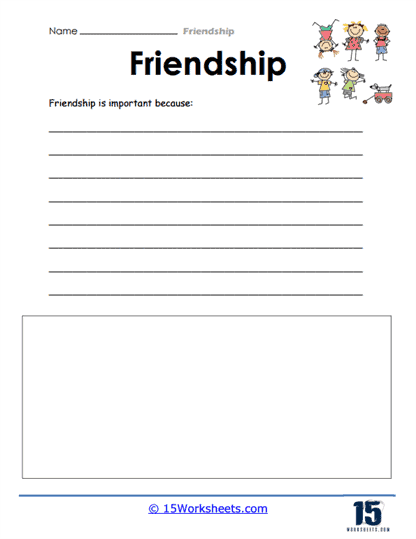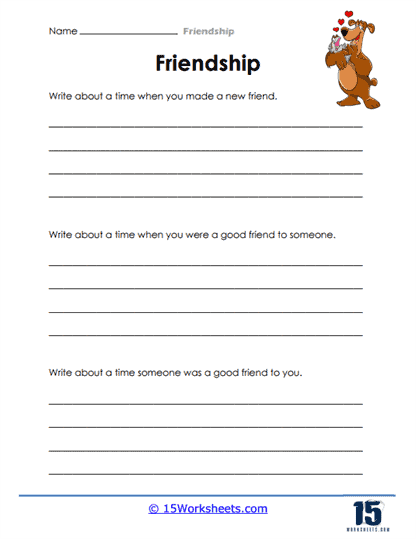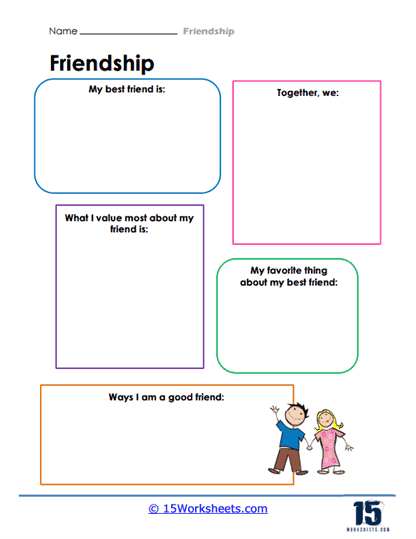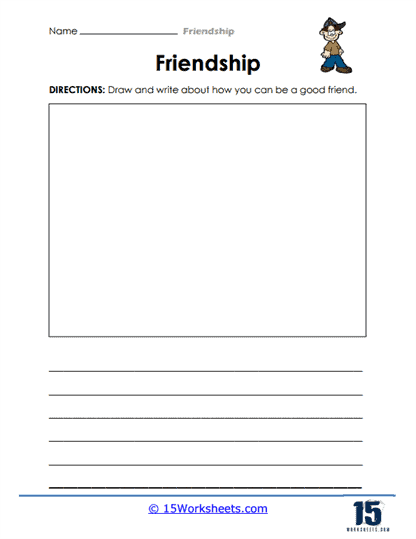Friendship Worksheets
About These 15 Worksheets
Friendships form the foundation of our social lives, shaping how we connect with others and offering us a space to feel understood, supported, and valued. However, creating and maintaining healthy, positive relationships is not always easy. It requires a combination of self-awareness, communication, empathy, and the ability to navigate the complexities of human emotions. To foster these skills, resources like friendship worksheets play a vital role, providing structured opportunities for students and individuals to explore, reflect upon, and enhance their understanding of what makes relationships thrive.
These worksheets go beyond mere academic exercises; they serve as powerful tools for personal growth and emotional development. Designed to guide meaningful conversations and introspection, they help individuals of all ages-whether in educational or therapeutic settings-think critically about the qualities that contribute to supportive friendships. Students, especially those in formative years, can benefit immensely from these worksheets as they encourage a deeper understanding of their own social behaviors and offer insight into how to cultivate more meaningful connections.
The activities within these worksheets are often centered around open-ended questions, role-playing scenarios, and reflective prompts that invite students to examine their current relationships. They might be asked to identify qualities they value in a friend or analyze the role they themselves play in their friendships. By engaging in such reflective practices, students become more aware of their own expectations, needs, and responsibilities within a friendship. This self-awareness is a critical first step toward building relationships that are rooted in mutual respect and understanding.
What makes these worksheets especially valuable is their ability to foster open dialogue. In a world where social interactions can be both rewarding and challenging, having structured opportunities to discuss friendship dynamics can be eye-opening. These discussions create a safe space where individuals can express their thoughts and feelings without judgment, learning from others’ perspectives and gaining insight into the diverse ways that relationships can be experienced. Such dialogue not only enhances interpersonal skills but also encourages empathy, as students learn to recognize and appreciate the emotions and experiences of those around them.
The worksheets provide guidance on navigating common challenges in friendships, such as resolving conflicts, setting boundaries, and managing misunderstandings. Often, people are unsure of how to approach these situations in real life, which can lead to frustration and, ultimately, damaged relationships. By practicing these scenarios in a controlled environment, students gain the confidence and skills necessary to handle conflicts constructively. They learn the importance of clear communication, active listening, and compromise-skills that are essential not just for friendships but for all types of relationships.
Another significant aspect of these worksheets is their emphasis on the emotional and psychological elements of friendship. They encourage individuals to reflect on how friendships make them fee-whether they feel supported, heard, and appreciated-or if they experience negative emotions such as insecurity or jealousy. This process of reflection allows individuals to recognize the relationships that are uplifting and positive, while also identifying those that may be toxic or unhealthy. The ability to differentiate between healthy and unhealthy friendships is crucial for personal well-being, as it empowers individuals to make informed decisions about who they allow into their lives.
In therapeutic settings, these worksheets can be transformative for individuals who may struggle with social anxiety, low self-esteem, or difficulty forming connections. Therapists often use these worksheets to help clients explore their feelings about friendship and to guide them toward healthier relationship patterns. Through guided exercises, clients can unpack past experiences, identify emotional barriers, and develop strategies for building more supportive, fulfilling relationships moving forward.
For younger students, friendship worksheets can be particularly impactful in shaping their early social development. Children and adolescents are still learning how to navigate social norms, manage their emotions, and form meaningful connections with their peers. These worksheets provide them with a framework for understanding the core qualities of friendship-such as trust, loyalty, and kindness-and how to embody these qualities in their interactions with others. By starting this process early, students are more likely to develop the skills necessary for forming strong, lasting friendships throughout their lives.
Types of Exercises on These Worksheets
Friendship Storytime
In this activity, there’s a short story about two friends. After reading, there might be questions like, “How did Sarah make Emily feel better?” or “Why were they laughing together?” This helps you think about what the characters did as friends.
Matching Emotions
Here, you might see faces showing different feelings – happy, sad, surprised, or angry. You’ll have to match the faces with situations like, “When a friend shares their toy,” or “When a friend takes your snack without asking.” It’s a fun way to learn about feelings in friendships!
Friendship Chain
This activity gives you sentences like, “A friend is someone who…” and you complete the sentence. You can write things like “listens to you” or “makes you laugh.” If you do this with friends, you can link all your sentences together to make a long chain of friendship ideas.
Draw Your Friendship
Get your colored pencils ready! This page lets you draw pictures of you and your friends doing fun things together. It’s like creating a friendship comic!
How To Teach Children About a Healthy Friendship
Friendship, much like a beautiful garden, requires care, patience, and understanding to blossom. To start, children should be taught the basic foundation of what makes a friendship healthy. This means explaining that friendships are built on trust, respect, and mutual appreciation. Just like how every flower is unique, every friendship is different. Some might grow quickly, while others take time. But every true friendship is based on kindness and understanding.
Recognizing Good Qualities
Children often mirror the behavior they see around them. By emphasizing the importance of being a good listener, being kind, sharing, and showing empathy, kids can learn to embody these positive traits in their own friendships. It’s also valuable for children to recognize these qualities in others. Encourage them to seek out friends who make them feel good about themselves, who listen to them, and who enjoy spending time together in positive and constructive ways.
Setting Boundaries
Just as gardens have fences, friendships have boundaries. It’s essential for children to understand that every person has limits and that these should be respected. Teaching children to say “no” when they’re uncomfortable and to understand when someone else says “no” is crucial. This can be practiced through role-playing exercises or discussions about hypothetical situations. This way, children can learn the importance of mutual respect and consent in friendships.
Dealing with Conflict
Even in the healthiest of friendships, disagreements or misunderstandings can arise, just like weeds in a garden. It’s important for children to know that occasional conflicts don’t mean the end of a friendship. What’s more vital is how these conflicts are addressed. Children should be taught to express their feelings calmly, listen to the other person’s side, and find a compromise or solution together. Avoiding blame and focusing on understanding can often lead to a quicker resolution.
Recognizing Unhealthy Signs
Just as it’s essential to know what makes a friendship blossom, it’s equally important to recognize when a friendship might be wilting. Teach children to be aware of signs like consistent teasing, feeling pressured to do things they’re uncomfortable with, or feeling left out. These can be indicators that a friendship is not as healthy as it should be. It’s crucial for them to know it’s okay to talk to trusted adults about their feelings and concerns in such situations.
Nurturing the Friendship
Like watering a garden, friendships need regular attention to thrive. Children should understand the importance of spending quality time with friends, checking in on them, and showing appreciation. This could be through shared activities, little acts of kindness, or simply being there when a friend needs them. Over time, these gestures strengthen the bond of friendship, making it resilient and long-lasting.


















